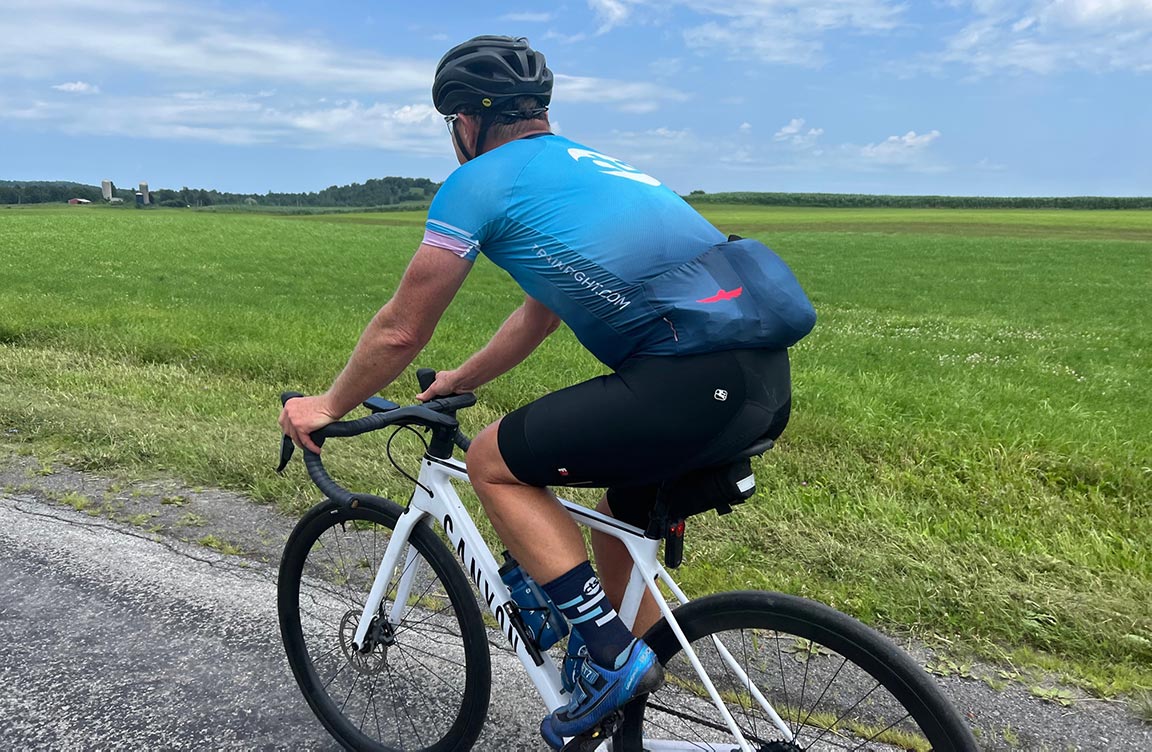
Knee Replacement Training Plan: One Year Post-Op Report
By Chris Carmichael,
CTS Founder and Chief Endurance Officer
One year after a total knee replacement surgery on my right leg, and 21 months after surgery to replace my left hip, I am finally feeling strong and durable as a cyclist again. As I near my 63rd birthday, I know I am one of many athletes in my age group who have had or will need joint replacement surgeries in the coming years. I have shared the stories of my old injuries and recent surgeries in previous posts (The Hip Replacement Training Plan: Returning to Cycling and Sport after Total Hip Arthroplasty and the Knee Replacement Training Plan: Returning to Cycling and Sport after Total Knee Replacement) and receive messages every week from athletes sharing their joint replacement stories and asking questions about their return to sport. As I’ve learned firsthand, there isn’t much information available for athletes who want to return to endurance sport training or competition following hip and knee replacements. That’s why I felt it was important to provide an update to my story on the one-year anniversary of my knee replacement.
Quick background summary
The articles linked above describe my surgeries, the injuries that necessitated them, and the rehabilitation work I completed to return to active training. The short version is this: In 1986 I broke my femur in a back-country ski accident, splitting the femoral condyles. In the resulting surgery I had a rod inserted into my femur and lost about 1 inch of length in my right leg. Over the next 35 years, I wore a lift in my right shoe off the bike and stacked cleats or had custom cycling shoes, but the injury eventually led to excess wear in my right knee.
My left hip compensated for my shortened right leg, and it too wore out. By 2021, the constant pain in both my hip and knee affected my daily activities, including my ability to ride my bike. Although I initially planned to have the knee replacement first, my hip deteriorated rapidly in the fall. As a result, I had my hip replaced first, in December 2021, and then my knee replaced in September 2022.
Comparing Hip and Knee Replacement Recoveries
Compared to my hip replacement, the recovery from my knee replacement was more painful, much slower, included more setbacks, and required more modifications to lifestyle behaviors, exercise routines, and equipment. If you’re heading for any joint replacement – and particularly a knee replacement, my advice is to be patient, be diligent and consistent with physical therapy, and approach your recovery like a training plan.
One Year Post-Knee Replacement: Lessons Learned
Lesson 1: Give Yourself a Full Year for Recovery
My orthopedic surgeon (Dr. Eric Jepson of Colorado Springs Orthopedic Group) told me it would take a full year to get over the surgery. Naturally, I didn’t believe it would take that long. I’ve been an athlete all my life, and call it ego or arrogance or life experience, I figured a full year was a conservative estimate. Surely, I could recover faster…
Nope, the doctors were right on the money. The pain in the knee joint and from the trauma of surgery lasted significantly longer than I anticipated. Within a few weeks the swelling around the knee joint subsided, but not completely. The residual, minor swelling was persistent. And because it was around the knee joint, even minor swelling diminished my right knee’s range of motion. The tension and stretch on the skin limited knee flexion and caused pain, and it took months for my right knee to even look normal.
I have only recently turned the corner, so to speak, and experienced a significant improvement in my right knee. In August 2023, nearly a year after the knee replacement, the residual pain and stiffness in my right knee diminished enough that it was no longer hindering my performance on the bike. Over the course of three weeks, my power output jumped up by 20-40 watts on climbs lasting 5 to 20 minutes. Those improvements were too large and rapid to be caused solely by training volume or time-at-intensity. The cardiorespiratory fitness was already there. The gains came from finally being pain free and hence able to effectively produce force – and therefore power – through my right knee.
Lesson #2: Commit to Physical Therapy Like It’s a Training Plan
Not self-advocating for more physical therapy was probably the biggest mistake I made throughout my entire hip and knee replacement journey. I recovered quickly from the hip replacement surgery and I found that physical therapy was downplayed for hip replacement patients. If you’re relatively healthy and active going into the surgery, doctors mainly recommend walking and a few weeks of physical therapy visits. (see hip replacement article above for details on my walking progression and exercises) My error was dropping the PT exercises after a few weeks, once I was back on the bike.
The decision to stop PT exercises, or strength training and significant walking/hiking, doomed my recovery from the knee replacement nine months later. The knee replacement was so debilitating that although I could walk a mile after two weeks, I struggled to extend those walks for around 6 weeks post-op. In contrast, I was walking within days of the hip replacement, progressed to mile-plus walks by 5 days post-op, and I was back to training – not just riding – on the bike in 3.5 months.
I should have focused more on strengthening my left hip and left leg before the surgery to replace by right knee. But because I didn’t, my left leg atrophied significantly due to inactivity following the knee surgery. Instead of being able to rely on my left side to compensate for the recovering right leg, both sides were weak. That led to strange compensations in how I stood, walked, and rode my bike.
Note: I wouldn’t change the spacing or separation between my hip and knee surgeries. Longer recovery time from the hip surgery wasn’t the problem. The problem was not strengthening my left leg sufficiently in anticipation of a prolonged period of diminished activity.
Lesson 3: Get a Post-Knee Surgery Bike Fit
Although I’ve probably done or supervised thousands of bike fits over the past 30 years, my riding position in early 2023 was essentially the same as it was when I was a professional bike racer. The stem was a bit higher, but saddle position, stem length, and bar width hadn’t changed. Following the knee surgery, I got back to riding pretty quickly and within six months my power outputs were just 10-15% below what I was capable of about a year before the hip surgery (i.e. before the pain really started diminishing performance).
With the pain and stiffness in my right knee diminishing, and despite some persistent swelling, I felt like I could push forward with my cycling training workload. I increased my weekly training volume to about 15 hours per week. My right knee would swell between rides and gradually get better as I rode, but the extent of the swelling got progressively worse over a period of weeks. Eventually the swelling contributed to developing bursitis, primarily driven by ramping up volume and the repetitive motion of cycling too aggressively.
Shorten crank length after knee surgery
I found a physical therapy practice that specializes in treating cyclists and other athletes, Revolutions in Fitness, in Mountain View, California. A bike fit with Curtis Cramblet was a key component of my recovery. The idea of transitioning to shorter crank arms is not new. It’s been popular in triathlon for several years, and of course shorter crank arms are common in velodrome events. I’ve ridden 172.5mm crank arms for decades. What I hadn’t considered was that shortening my crank arms to 165mm could lessen knee flexion at the top of the pedal stroke, where I was having trouble with skin tension due to inflammation.
► Free Cycling Training Assessment Quiz
Take our free 2-minute quiz to discover how effective your training is and get recommendations for how you can improve.
I had been trying to alleviate that tension by raising my saddle, which caused too much knee extension at the bottom of the pedal stroke and calf cramps from using my lower leg muscles in a new way. A key consideration after shortening crank length was following up by lowering the saddle height, a piece of the equation that’s often missed.
Raise your stem
I am guilty of holding on to “bike racer” ideas of what my road and gravel bikes should look like. I was far from having a slammed stem, but I’ve tried to keep the stack of spacers under my stem reasonably small. Following the hip surgery, I got back to my normal riding position pretty quickly. Following the knee surgery and in conjunction with the shorter cranks, raising my stem was an effective means for opening up my hip angle and further reducing tension on my right knee.
Lesson #4: Focus on Building Strength Before and After Surgery
Strength training is important for aging athletes. Sarcopenia causes a gradual loss of muscle mass as we get older and muscle protein synthesis to build and repair muscle becomes less efficient at the same time. I made the mistake of not doing enough strength training between my hip and knee surgeries. The result was evident when I returned to training after the knee surgery. My left/right power balance was 45L/55R in early 2023. Despite the more recent knee surgery, my left hip side was the weaker one! In late August 2023, I did a 60-mile ride in Santa Ynez, California with 5-minute efforts up Drum Canyon. I achieved my 4th fastest time and 3rd highest power output for the last ten years. And my left/right power balance was 49L/51R. A 10-point spread, which had reduced to a six-point spread in the spring, is now back to normal.
Lesson #5: Work with medical professionals who understand athletes
From the beginning, I chose Dr. Eric Jepson and Colorado Springs Orthopedic Group because of their experience with athletes. What I learned in the year after my knee surgery was that I needed a team that included physical therapists, a bike fitter experienced with joint surgeries, and access to orthopedic surgeons for questions and conversations. I am particularly thankful for physical therapy guidance from Dr. Juliet St Germain and bike fit from Curtis Cramblet at Revolutions in Fitness and to fellow cyclist and orthopedic surgeon Dr. Douglas Tice.
Differentiate skeletal vs. soft tissue problems
Have a meaningful conversation with your orthopedic surgeon about the difference between a skeletal issue (e.g., joint replacement, fractured bone) and a soft tissue problem (e.g., torn anterior cruciate ligament, torn meniscus). Once the surgery and acute recovery were complete, my knee was stable. Yes, there was inflammation and trauma from surgery that needed to heal, but it was important for me to know I wasn’t going to damage to anything by moving. Pain was the limiting factor in how much I could move or exercise and moving would accelerate healing (up to a point, which I exceeded…). However, an ACL or meniscus injury takes considerably more time to rehabilitate. You need to be more cautious on how quickly you advance because you can tear soft tissues.
Absorb advice and trust yourself
Through 50 years of being an athlete and coach, I’ve learned a lot about how adaptable the human body is. I think I’m pretty good at manipulating stress and recovery to improve cardiorespiratory performance, strengthen muscles, and even remodel bone tissue. I understand how to utilize nutrition to support recovery and performance. But I needed specialized guidance from medical professionals, physical therapists, and bike fitters to recover from two joint replacements in less than two years.
At the same time, I also needed to trust myself and the skills and mentality that have served me through nearly 63 years on this planet. My doctors were concerned I’d crash if I rode outdoors too soon. That’s a valid concern, but I was more apt to trip and fall walking. And when it came to the volume of riding I could handle, I used the medical advice to differentiate between pain and harm. Pain I could handle, so long as I wasn’t risking harm.
When should you have joint replacement surgeries?
Mobility is longevity and independence. As I get older and see my peers and older role models age, it’s clear that restricted mobility contributes to a cascade of progressively detrimental health consequences. That’s important when considering joint replacement surgeries. All the advice I received before surgery was to keep my “original equipment” as long as possible. And I think that’s good advice.
You never know what will happen in surgery, so keep what you have until it’s really impacting normal function. I tried stem cell therapy to extend the time before needing surgery. Results vary, but my personal experience I found it expensive, not covered by insurance, and only mildly effective at reducing knee pain for about a month. I had reached the point the knee and hip were affecting my mobility and starting to affect my overall health. So, it was the right time to get them replaced.
How I plan to get 20 years out of my new joints
Hip and knee replacements generally happen to people in their 50s, 60s, and 70s. The surgeries themselves are hard to recover from, and I was a healthy, active person with a long exercise history. But I was also a one trick pony, a cyclist who really only rode bikes. The prolonged periods of diminished activity and losses of muscle mass and range of motion were wake up calls. The losses didn’t happen all at once or just from the surgeries. I’d been losing muscle and flexibility and range of motion for years, but so slowly that I barely noticed.
Cycling obscures some of the losses because you have great aerobic fitness and big rides provide the perception of great athletic capacity. Even with decades of coaching experience and a good grasp on the science, I’ve been surprised by how much I need to do to combat process of losing muscle mass and preserving flexibility in my 60s. My cardiovascular fitness is great, as is my strength in the specific movements of cycling, but in other aspects of life I’m vulnerable.
You can gain strength at any age, but it gets harder to build and maintain muscle mass as you get older because of inefficient muscle protein synthesis and hormonal changes. The doctors say I can probably get 20 years out of my new knee. That’s great, but to be around in 20 years to get another one I have committed to the steps my coaches and I have long recommended for others, including strength training 2-3 times per week year round, a flexibility/range of motion program, and increased protein intake (up to about 1.8-2.0 grams per kilogram of bodyweight per day, consumed throughout the day).
► FREE Mini-Course: Learn How to Maximize Your Limited Training Time
Learn step-by-step how to overcome limited training time and get faster. Walk away with a personalized plan to increase your performance.
"*" indicates required fields

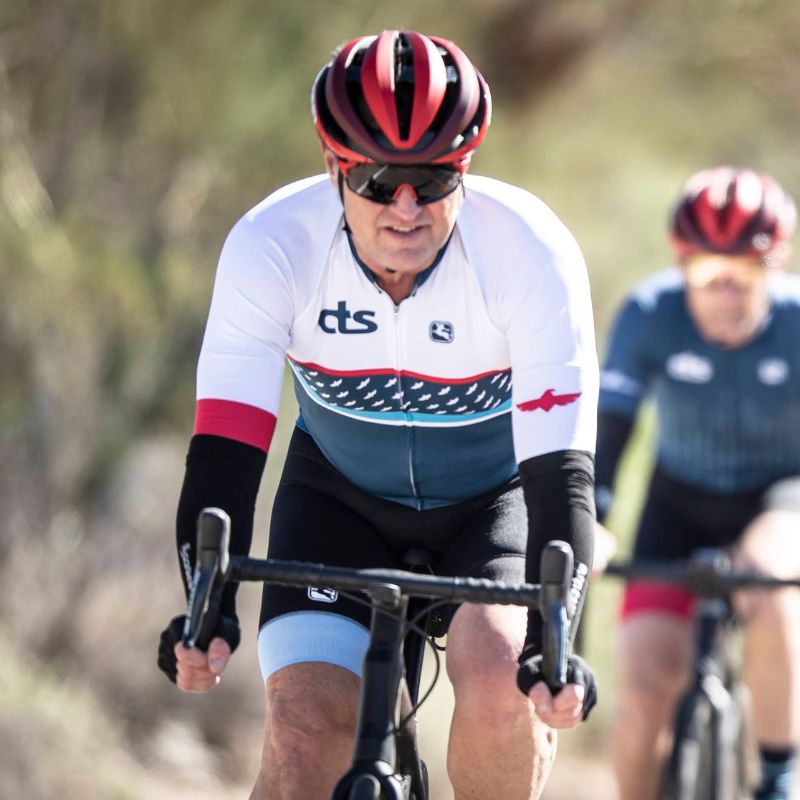
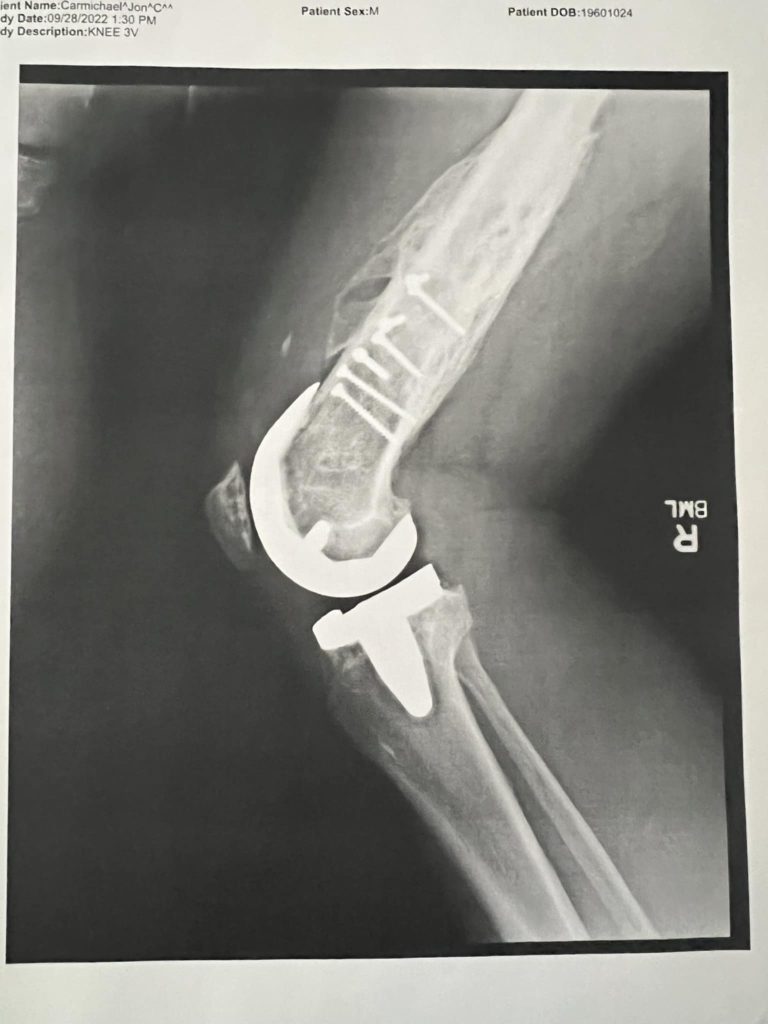
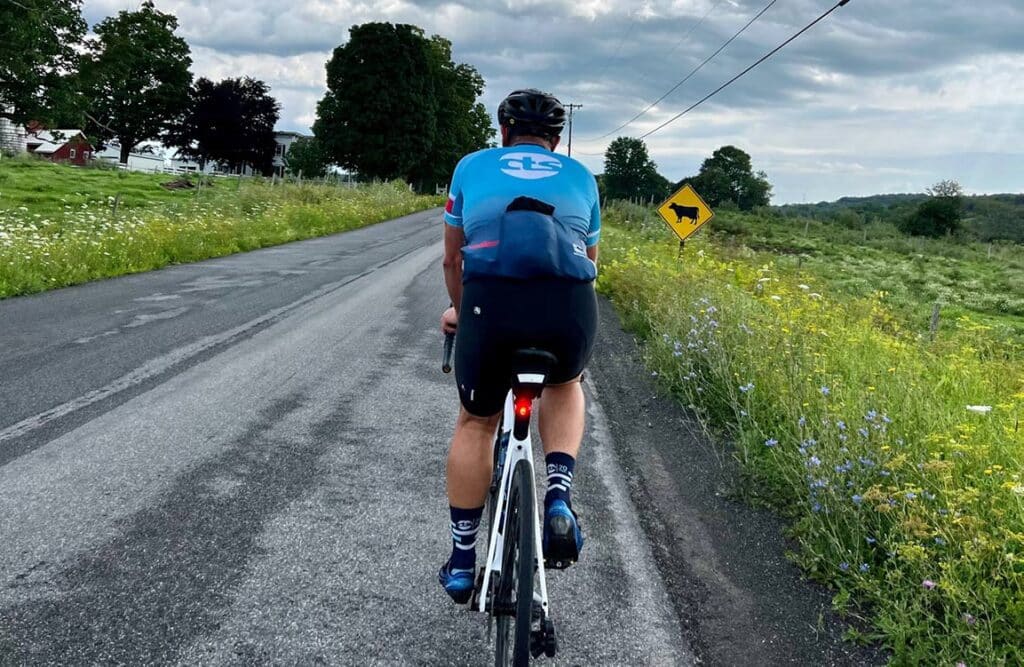
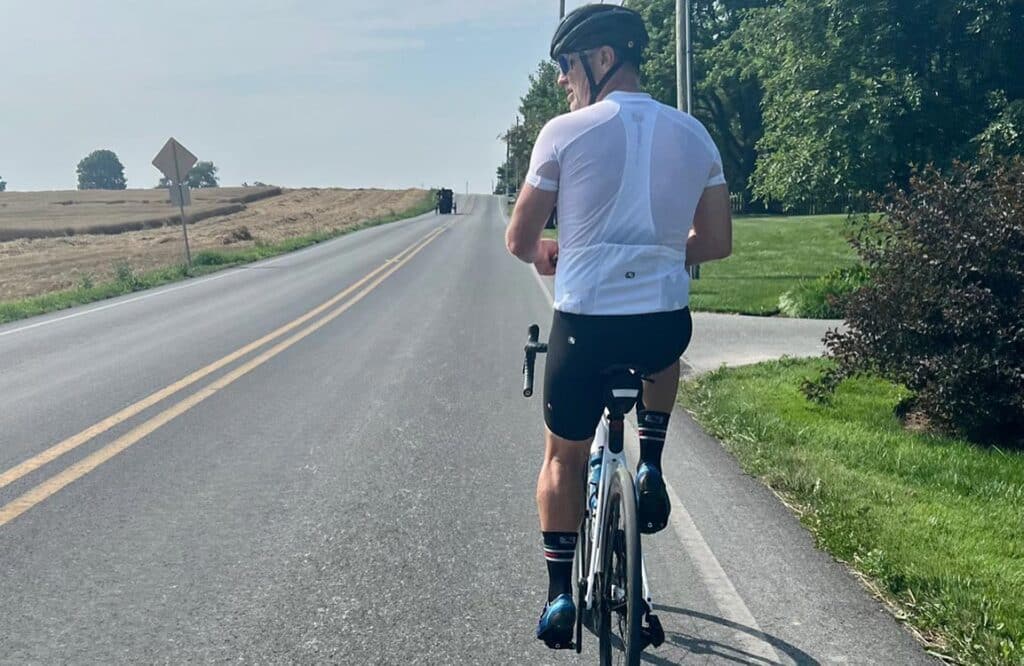
Comments 14
First, it’s really cool to see the perspective of a true athlete on this subject. I’m not world-class, but am an accomplished age-group athlete in duathlons [run,bike,run] and the Concept2 world wide indoor rowing community. Had a custom made knee prosthetic implanted Nov 20, 2024, just before turning 79. To say it has been more difficult than anticipated is a huge understatement. For the first 3 weeks, leg swollen like a balloon. Surgeon used tourniquet technique which has resulted in considerable trauma to the quad and massive swelling. I thought I had another DVT, but I do take Xarelto.
In the last 10 days or so, started easy rowing and spinning on spin bike. ROM improving enough to do those. Am doing as much in knee stretching as I can including mini step ups, stair navigation, half squats, etc. I roll my own PT.
For a while, I was wondering if this entire TKR process was just a bad joke. But I think there is light at the end of the tunnel. I want good ROM, ability to climb stairs with no assistance, and no knee pain.
Thanks for reading.
Thank you so much for publishing this…
Turning 70 in a couple of months and its been 10 months since my right TKR and feeling frustrated with my progress. Did a big build over 3 months using Zwift to prepare my knee and have started building again but year over year numbers for the same course show a dramatic increase in HR for the same power numbers…
Your number 1 lesson “Give Yourself A Full Year For Recovery” really hit home with me and I have to learn to be patient!
Thanks again!!
Pingback: 4 Training Myths for Cyclists 50 and Older - Chris Carmichael
Chris, thanks for the great article and congrats on your progress. My situation is a little different in that I broke several bones when I was hit by a truck while riding earlier this year, so I didn’t have the opportunity to plan for my surgery and recovery. Your point about needing a full year for recovery is well-taken, and I was given similar advice by my doctors and PTs. Right now, 7-1/2 months later, I’m going through a bit of a setback that I think was caused by me trying to ramp up my core exercises a bit too much a couple of weeks ago, and I have to keep reminding myself of the 1-year expectation.
Good article! I’m currently recovering from a crash which broke my wrist. I’ve also experienced hip trauma in the past (cycling can be a bone game). I’m a CTS athlete and it’s good to know I’m not the only one struggling with recovery at this stage in life.
My surgeon, an avid cyclist, doesn’t feel that long distant rides do any harm to joints, before or after surgeries (I’ve had 4 joint replacements and am 69).
Should I keep my rides shorter so as not to wear out the hardware sooner?
I just saw Dr Jepson for my 6 week post op after hip replacement. I was totally lifted from all restrictions. I was an avid cyclist, teach pilates and did hot yoga before surgery. During my recovery I have used my pelaton since week two for 2 workouts a day. I walked on a 3X’s a day schedule. Movement is the key to a successful recovery. There is a limit as well. Listen to your body. Stop when pain hits. At that point elevate and ice! Take the time to heal. Work will be there when you are ready to go back feeling strong and stable. Give yourself the grace and the love you would give to others going thru the same thing. It’s worth every second of the work you put in to recovery. Good luck to all facing hip replacement or knee replacement surgery!
Chris – awesome job in recovering from both surgeries. I had a double knee replacement just over two years ago and agree that it takes time. I was walking up steps before leaving the hospital. My early therapy focused on range of motion the first four weeks – I was on an indoor exercise bike within 5 days of surgery and back to my spin class on day 30. Finished my first Grand Fondo New Year in May this year and while both legs feel much stronger – at 66 years old the hills are still a challenge. Weight training six weeks before surgery surely helped. I will be disappointed if I only get 20 years out of these knees. I’ve actually cut back on overall mileage in hopes of not wearing out too soon.
Thanks for the article. Like you, I had my right knee and left hip replaced, just in a different order than you.
I had my knee replaced over 6 years ago. I had waited way too long to do so as the xrays showed I was bone on bone, in fact the surgeon estimated I had lost a total of close to 1/2 inch of bone. This made rehab more painful as not only did I have to deal with the new joint but also the stretching of the tendons surrounding the knee … one reason to strongly consider joint replacement earlier than later. They ended my “official rehab” after 30 days and left me to continue on my own as what I was doing on an indoor trainer and body-weight strength training was working so well. I was “freed” to start riding outdoors after 90 days and rode 100 mile at Unbound in 6 months.
I had my hip replaced about two years ago. Like my knee, I had much bone deterioration which created problems with nerves running through the hip and manifested itself in major pain in my left knee. Surgery went well and I was walking on a treadmill (30-minute miles) within 24 hours. Assigned self-rehab of walking and indoor trainer for 30 days and was allowed to bike outdoors in 60 days.
What I learned
1. Have joint replaced before you lose a substantial amount of bone as you will not only have to deal with the new joint but also the surrounding shortened muscles and tendons.
2. Religiously stick to joint rehab as prescribed.
3. Use an indoor trainer … nothing beats it for improving new joint mobility. Start with little/no resistance.
Spot on, Chris! As a Coach of Robust Aging, it is imperative that we restore and refill all 7S Functional Freedom Training Buckets, then fight like crazy to keep them ALL full, not just the ones we like and are good at!
“Functional mobility is the difference between thriving in our own homes, and moving to assisted living.”
You and your team do great work!
Chris, Congratulations on your improvements. GREAT ARTICLE! One of the BEST. WOW. An increase in power, after a year of Re-hab ( including the one year mark) FANTASTIC. I’m a CTS athlete/CTS camp participant. ALL your coaches subscribe to all-round physical fitness/weightlifting. Sharing your personal story was SUPER!
Thanks Much
David
I had a total knee replacement June 21 of this year possibly no actually definitely the worst procedure I’ve ever had in my life and that included can you donation to my mom in 1993. I would strongly recommend every human being to think five or six times before doing it. I interviewed five surgeons and ended up with the last one as I thought he was the most experienced and local to help me get through this and he does probably upwards of 14 a week, the struggles with three weeks ago having a manipulation under anesthesia to try to get the range of motion back has not been good. Still the range of motion is awful and I’m set up now possibly with having another procedure to remove the score tissue and adhesions for them left with , my bike 100 miles a week haven’t been on a bike since June although riding with this comfort indoors at the 12 o’clock position when they need is most flexed is very difficult to go to therapy after the procedure six times a week and now three times a week since June that’s about 105 days of therapy I hope this area sometime soon as I can get back on my bike at 73 it was my hobby, my joy in my love, very disgusted with this procedure, and where I currently am.
Lou – I just want to say “hang in there” and hopefully it will be better soon. Sending healing thoughts your way.
All the best to you, Lou. I can only imagine how disappointed you are; my recovery from TKR has been relatively smooth, aside from a superficial infection at the top of the stitches and, of course, loss of sleep and disruption of normal activities. But, while healing from such an invasive surgery can never be a picnic, you are facing a much greater challenge than many of us.
I hope you are able to work through the considerable limitations you are experiencing, and I wish you the best of luck and a speedy return to what makes you happy.